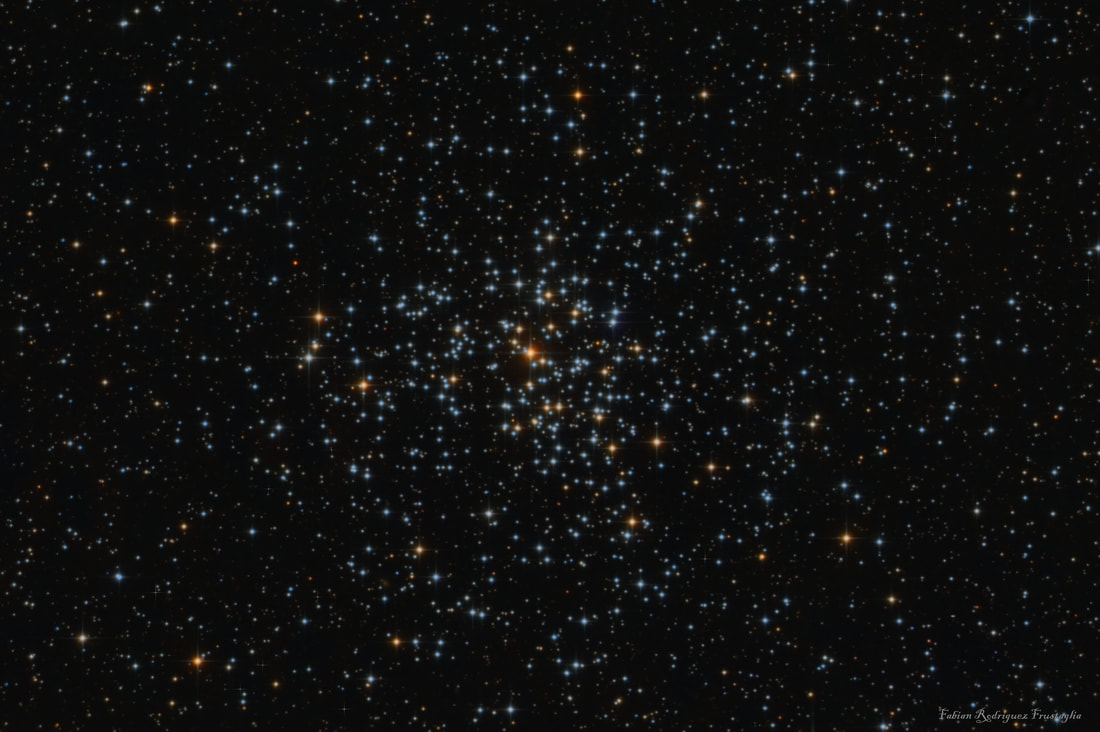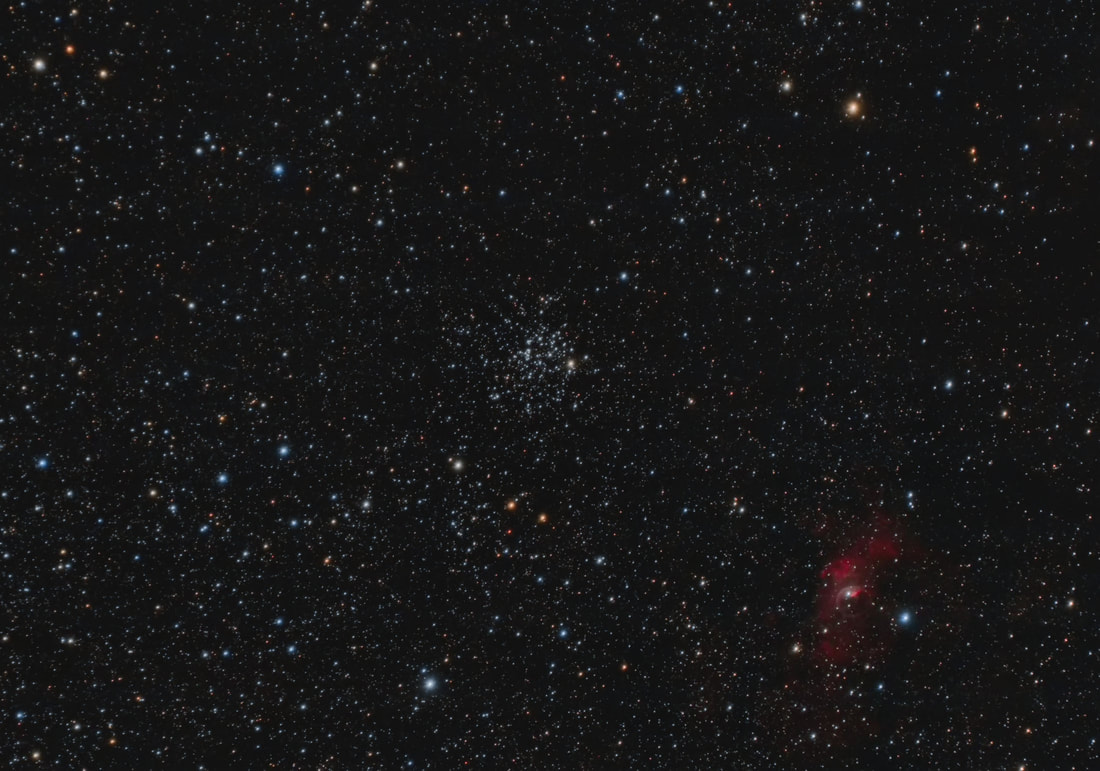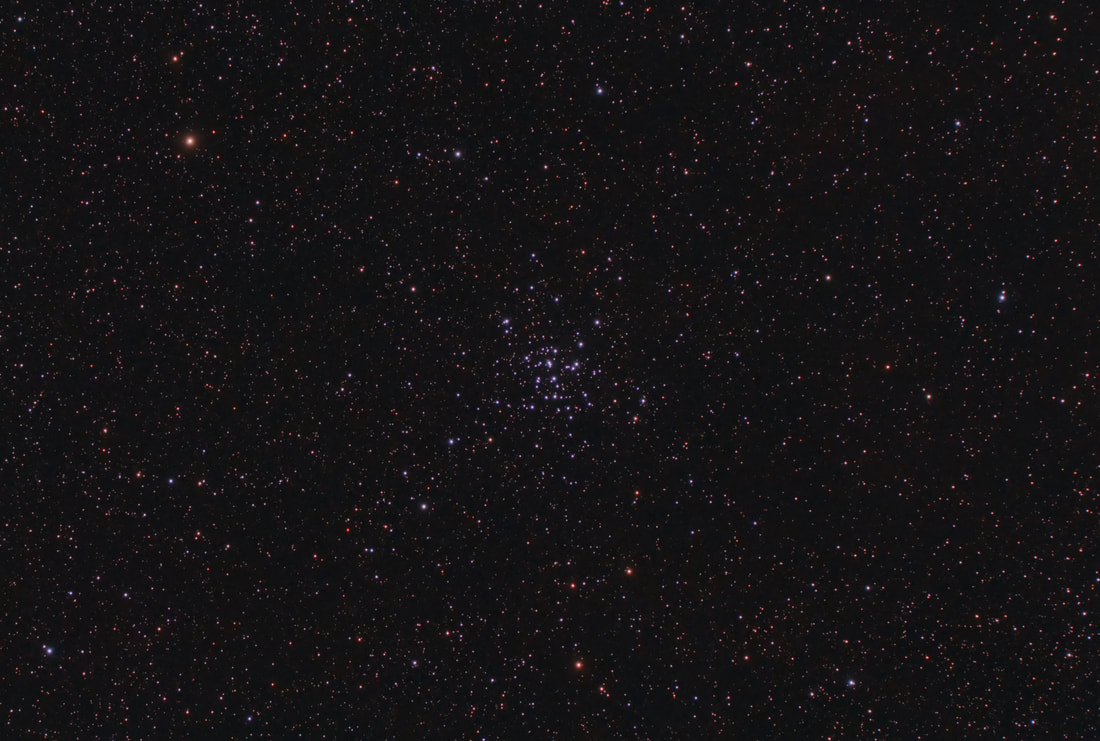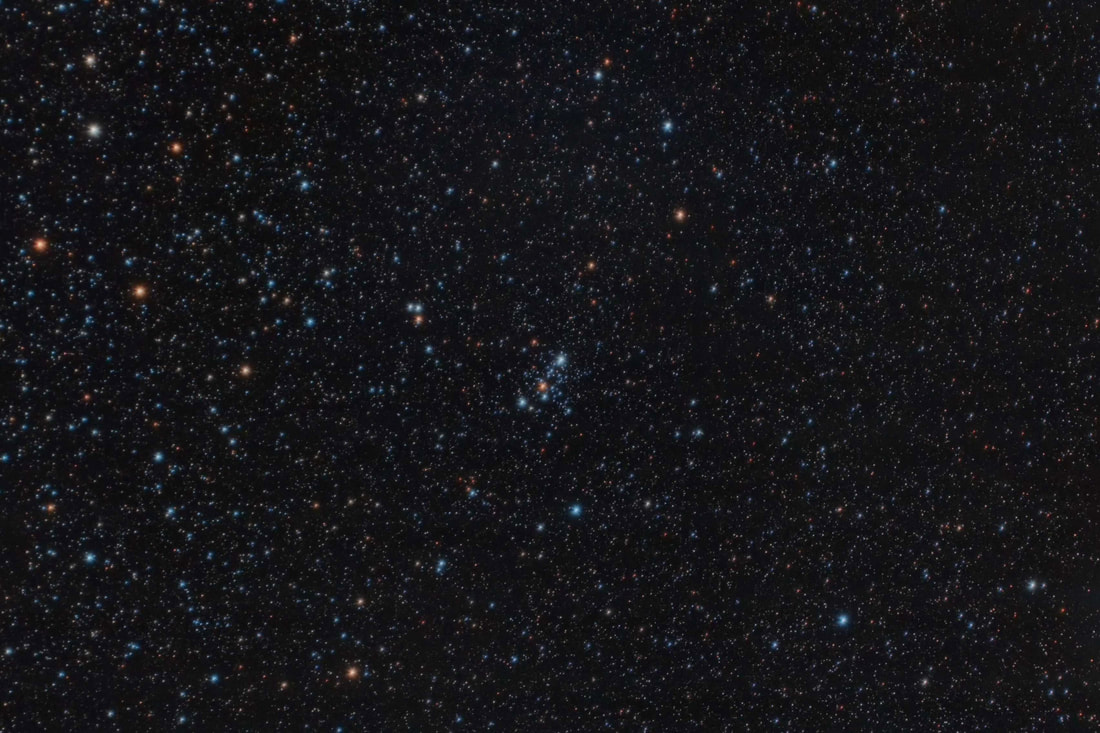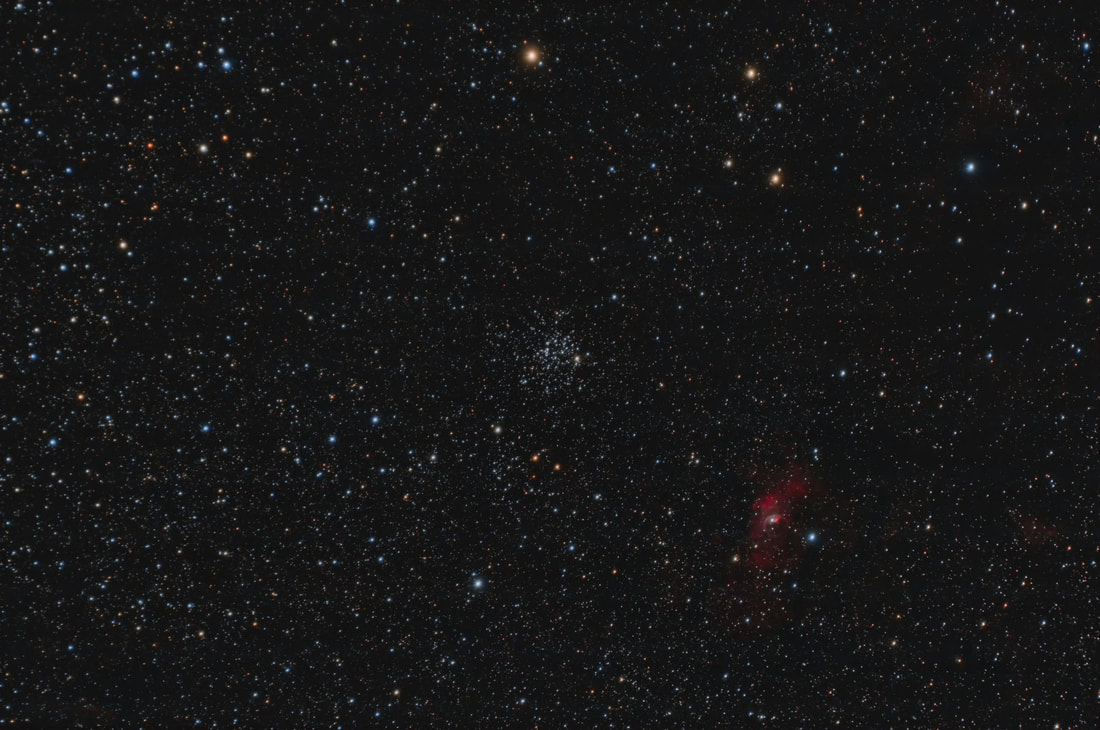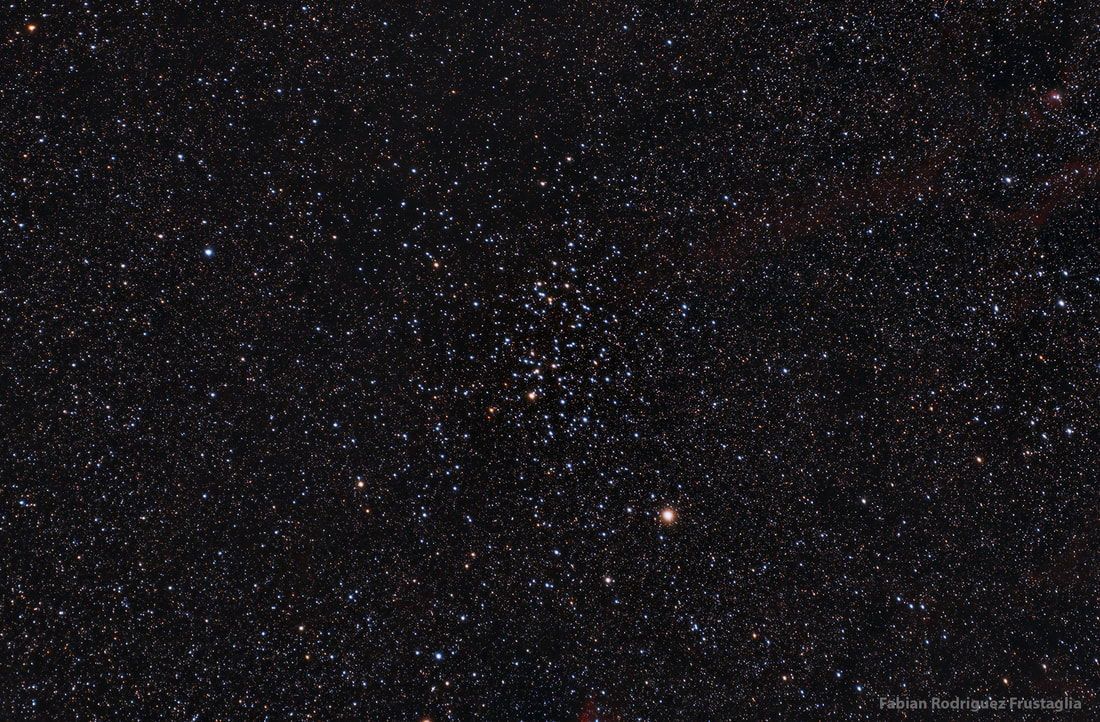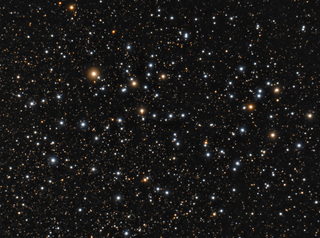Open Clusters
CLICK ON AN IMAGE TO VIEW IT AT FULL RESOLUTION
|
Messier 44 - Beehive Cluster
The Beehive Cluster (also known as Praesepe (Latin for "manger" or "crib"), M44, NGC 2632, or Cr 189), is an open cluster in the constellation Cancer. One of the nearest open clusters to Earth, it contains a larger population of stars than other nearby bright open clusters holding around 1,000 stars. Under dark skies, the Beehive Cluster looks like a small nebulous object to the naked eye, and has been known since ancient times. Classical astronomer Ptolemy described it as a "nebulous mass in the breast of Cancer". It was among the first objects that Galileo studied with his telescope. Telescope: Meade Series 6000 APO 115 f/5.6 Camera: ZWO ASI2600m Filter: ZWO RGB Date: January 2023 Exposure: 36x 300" = 3.0 hrs |
|
Messier 37
Messier 37 (also known as M37 or NGC 2099) is the brightest and richest open cluster in the constellation Auriga. It was discovered by the Italian astronomer Giovanni Battista Hodierna before 1654. M37 was missed by French astronomer Guillaume Le Gentil when he rediscovered M36 and M38 in 1749. French astronomer Charles Messier independently rediscovered M37 in September 1764 but all three of these clusters were recorded by Hodierna. Telescope: Meade Series 6000 APO 115 f/5.6 Camera: ZWO ASI2600m Filter: ZWO RGB Date: February 2023 Exposure: 38x 300" = 3.16 hrs |
|
Messier 67 - Golden Eye Cluster
Messier 67 (also known as M67 or NGC 2682) and sometimes called the King Cobra cluster or the Golden Eye cluster is an open cluster in the southern, equatorial half of Cancer. It was discovered by Johann Gottfried Koehler in 1779. Estimates of its age range between 3.2 and 5 billion years. Distance estimates are likewise varied, but typically are 800–900 parsecs (2,600–2,900 ly). Estimates of 855, 840, and 815 pc were established via binary star modelling and infrared color-magnitude diagram fitting Telescope: Meade Series 6000 APO 115 f/5.6 Camera: ZWO ASI2600m Filter: ZWO RGB Date: January 2023 Exposure: 34x 300" = 4.4 hrs |
|
Melotte 111 - The Coma cluster
The Coma Star Cluster (also known as Melotte 111 or Collinder 256) is a small but nearby open cluster located in the constellation Coma Berenices. The cluster contains about 40 brighter stars (between magnitudes 5 and 10) with a common proper motion. The brighter stars of the cluster make out a distinctive "V" shape as seen when Coma Berenices is rising. The cluster used to represent the tail of Leo. However, in around 240 BC, Ptolemy III renamed it for the Egyptian queen Berenice's legendary sacrifice of her hair. Telescope: Meade Series 6000 APO 115 f/5.6 Camera: ZWO ASI2600m Filter: ZWO RGB Date: January 2023 Exposure: 72x 300" = 6.0 hrs |
|
Messier 52 & Bubble Nebula
Messier 52 or M52, also known as NGC 7654, is an open cluster of stars in the highly northern constellation of Cassiopeia. It was discovered by Charles Messier on 1774. It can be seen from Earth under a good night sky with binoculars. The brightness of the cluster is influenced by extinction, which is stronger in the southern half. Telescope: Meade Series 6000 APO 115 f/5.6 Camera: ZWO ASI2600 Filter: ZWO RGB Date: November 2021 Exposure: 36x 300" = 3.0 hrs |
|
Melotte 25
The Hyades (also known as Caldwell 41, Collinder 50, or Melotte 25) is the nearest open cluster and one of the best-studied star clusters. Located about 153 light-years (47 parsecs) away from the Sun, it consists of a roughly spherical group of hundreds of stars sharing the same age, place of origin, chemical characteristics, and motion through space. From the perspective of observers on Earth, the Hyades Cluster appears in the constellation Taurus, where its brightest stars form a "V" shape along with the still-brighter Aldebaran. However, Aldebaran is unrelated to the Hyades, as it is located much closer to Earth and merely happens to lie along the same line of sight. The five brightest member stars of the Hyades have consumed the hydrogen fuel at their cores and are now evolving into giant stars. Four of these stars, with Bayer designations Gamma, Delta 1, Epsilon, and Theta Tauri, form an asterism that is traditionally identified as the head of Taurus the Bull. The fifth of these stars is Theta1 Tauri, a tight naked-eye companion to the brighter Theta2 Tauri. Epsilon Tauri, known as Ain (the "Bull's Eye"), has a gas giant exoplanet candidate, the first planet to be found in any open cluster. Telescope: Meade Series 6000 APO 115 f/5.6 Camera: ZWO ASI2600 Filter: ZWO RGB Date: December 2021 Exposure: 48x 300" = 4.0 hrs |
|
This image has been awarded PICTURE OF THE DAY by Astronomy Magazine !!!!
|
NGC 225
NGC 225 is an open cluster in the constellation Cassiopeia. It is located roughly 2100 light-years from Earth. Also associated with this cluster is the bright nebula vdB4 (LBN 604). This may be the remnant of the nebula that formed this star cluster. Also dark nebulas LDN 1302 and 1292 are visible in the image. Telescope: Meade Series 6000 APO 115 f/5.6 Camera: ZWO ASI1600 Filter: ZWO RGB Date: August 2020 Exposure: 120 x 300" = 10.0 hrs |
|
Messier 35
Messier 35 or M35, also known as NGC 2168, is an open cluster of stars in the northern constellation of Gemini. It was discovered by Philippe Loys de Cheseaux around 1745 and independently discovered by John Bevis before 1750. The cluster is scattered over an area of the sky almost the size of the full moon and is located 3,870 light-years from Earth. The compact open cluster NGC 2158 lies directly southwest of M35. Telescope: Meade Series 6000 APO 115 f/5.6 Camera: QHY-168C Filter: Optolong L-Pro Date: March 2020 Exposure: 50 x 120" = 1.7 hrs |
|
Messier 38
Messier 38 (NGC 1912) is an open star cluster deep space object. It is not located in the Solar System. It lies at a distance of about 4,200.00 light years away in the constellation of Auriga. Telescope: Meade Series 6000 APO 115 f/5.6 Camera: QHY-168C Filter: Optolong L-Pro Date: March 2020 Exposure: 45 x 120" = 1.5 hrs |
|
Messier 36
Messier 36 or M36, also known as NGC 1960, is an open cluster of stars in the Auriga constellation. The cluster was independently re-discovered by Guillaume Le Gentil in 1749, then Charles Messier observed it in 1764 and added it to his catalogue. M36 is at a distance of about 1,330 pc (4,340 light years) away from Earth. The cluster is very similar to the Pleiades cluster (M45), and if it were the same distance from Earth it would be of similar magnitude. Telescope: Meade Series 6000 APO 115 f/5.6 Camera: QHY-168C Filter: Optolong L-Pro Date: March 2020 Exposure: 45 x 120" = 1.5 hrs |
|
Messier 67
Messier 67 (also known as M67 or NGC 2682) is an open cluster in the constellation of Cancer. Age estimates for the cluster range between 3.2 and 5 billion years. Distance estimates are likewise varied and typically range between 800–900 pc. Estimates of 855, 840, and 815 pc were established via binary star modelling and infrared color-magnitude diagram fitting, accordingly. M67 is not the oldest known open cluster, but Galactic clusters known to be older are few, and none of those is closer than M67. Telescope: Meade Series 6000 APO 115 f/5.6 Camera: QHY-168C Filter: Optolong L-Pro Date: March 2020 Exposure: 5 x 120" = 0.2 hrs |
|
NGC 1708
NGC 1708 is an open cluster in the constellation Camelopardalis. This was one of the first light objects for the new Meade APO 115mm the I received from the factory. Telescope: Meade Series 6000 APO 115 f/5.6 Camera: QHY-168C Filter: Optolong L-Pro Date: December 2019 Exposure: 54 x 120" = 1.8 hrs |
|
Double Cluster
The Double Cluster (also known as Caldwell 14) is the common name for the open clusters NGC 869 and NGC 884 (often designated h Persei and χ Persei, respectively), which are close together in the constellation Perseus. Both visible with the naked eye, NGC 869 and NGC 884 lie at a distance of 7500 light years Telescope: William Optics GTF-81 f/5.0 Camera: QHY-168C Filter: Optolong L-Pro Date: September 2019 Exposure: 80 x 120" = 2.7 hrs |
|
Messier 29
Messier 29, also known as NGC 6913, is an open cluster of star in the Cygnus constellation. It was discovered by Charles Messier in 1764, and can be seen from Earth by using binoculars. The star cluster is situated in the highly crowded area of Milky Way near Gamma Cygni, at a distance of 7,200. Messier 29 can be found quite easily as it is about 1.7 degrees south and a little east of Gamma or 37 Cygni (Sadr). In the vicinity of Messier 29, there is some diffuse nebulosity which can be detected in photographs. Telescope: William Optics GTF-81 f/5.0 Camera: QHY-168C Filter: Optolong L-Pro Date: September 2019 Exposure: 60 x 120" = 2.0 hrs |
|
Messier 39
Messier 39 or M39, also known as NGC 7092, is an open cluster of stars in the constellation of Cygnus, positioned two degrees to the south of the star Pi Cygni and around 9° east-northeast of Deneb. The cluster was discovered by Guillaume Le Gentil in 1749, then Charles Messier added it to his catalogue in 1764. When observed in a small telescope at low power the cluster shows around two dozen members, but it is best observed with binoculars. It has a total integrated magnitude (brightness) of 5.5 and spans an angular diameter of 29 arcminutes – about the size of the full Moon. M39 is at a distance of about 1,010 light-years from the Sun. Telescope: William Optics GTF-81 f/5.0 Camera: QHY-168C Filter: Optolong L-Pro Date: September 2019 Exposure: 60 x 120" = 2.0 hrs |
|
Messier 103
Messier 103 (also known as M103, or NGC 581) is an open cluster where a few thousand stars formed in the constellation Cassiopeia. This open cluster was discovered in 1781 by Charles Messier's friend and collaborator Pierre Méchain. It is one of the most distant open clusters known, with distances of 8,000 to 9,500 light-years from the earth and ranging about 15 light-years apart. There are about 40 member stars within M103, two of which have magnitudes 10.5, and a 10.8 red giant, which is the brightest within the cluster. M103 is about 25 million years old Telescope: William Optics GTF-81 f/5.0 Camera: QHY-168C Filter: Optolong L-Pro Date: September 2019 Exposure: 89 x 120" = 3.0 hrs |
|
Messier 52
Messier 52 or M52, also known as NGC 7654, is an open cluster of stars in the northern constellation of Cassiopeia. It was discovered by Charles Messier on September 7, 1774. M52 can be seen from Earth with binoculars. The brightness of the cluster is influenced by extinction, which is stronger in the southern half Telescope: William Optics GTF-81 f/5.0 Camera: QHY-168C Filter: Optolong L-Pro Date: September 2019 Exposure: 71 x 120" = 3.4 hrs |
|
NGC 3532
NGC 3532, also commonly known as the Football Cluster or the Wishing Well Cluster,[ is an open cluster some 405 parsecs from Earth in the constellation Carina. Its population of approximately 150 stars of 7th magnitude or fainter includes seven red giants and seven white dwarfs. Telescope: William Optics GTF-81 f/5.0 Camera: QHY-168C Date: April 2018 Exposure: 18 x 5' = 1.5 hrs |
|
Messier 45 - The Pleiades
The Pleiades (also known as the Seven Sisters and Messier 45), are an open star cluster containing middle-aged, hot B-type stars located in the constellation of Taurus. It is among the nearest star clusters to Earth at around 444 ly and is the cluster most obvious to the naked eye in the night sky. The cluster is dominated by hot blue and extremely luminous stars that have formed within the last 100 million years. Dust that forms a faint reflection nebulosity around the brightest stars was thought at first to be left over from the formation of the cluster (hence the alternative name Maia Nebula after the star Maia), but is now known to be an unrelated dust cloud in the interstellar medium, through which the stars are currently passing. Telescope: William Optics GTF-81 f/5.0 Camera: QHY-9 Date: November 2017 Exposure: Lum 16 x 5' + RGB 5 x 10' = 3.8 hr |
|
NGC 6400
NGC 6400 is an open cluster located in the constellation Scorpius. It is designated as II2m in the galaxy morphological classification scheme and was discovered by the Scottish astronomer James Dunlop on 13 May 1826. It is at a distance of 3,097 light years away from earth Telescope: Meade LX850 12" f/8.0 Camera: QHY-9 Date: June 2017 Exposure: 27 x 10' = 2.3 hr |
|
Melotte 105
Melotte 105 - object number 105 in the catalogue of star clusters by the British-Belgian astronomer Philibert Jacques Melotte (Jan 29, 1880 - Mar 30, 1961) - is the first of two clusters that lie within a degree of each other in north-eastern Carina at the Centaurus border. It has a combined magnitude of 8.5, and contains about 70 stars of mag 11.1 and fainter, covering about 4' of sky. Telescope: Meade LX850 12" f/8.0 Camera: QHY-9 Date: June 2017 Exposure: 6 x 10' = 1 hr |
|
NGC 6231
NGC 6231 is an open cluster located near Zeta Scorpii. Zeta1 (HR 6262) is a member of this star cluster. Its brighter apparent partner, Zeta2 (HR 6271), is only 150 ly from Earth and so is not a cluster member. This cluster is estimated about 2–7 million years old, and is approaching the Solar System at 22 km/s. The cluster belongs to the young Scorpius OB1 association. Zeta1 Scorpii (spectral type O8 and magnitude 4.71) is the brightest star in the association, and one of the most radiant stars known in the galaxy. Telescope: Meade LX850 12" f/8.0 Camera: QHY-9 Date: June 2017 Exposure: 27 x 10' = 2.3 hr |
|
NGC 5460
NGC 5460 is a bright and loose open cluster in the constellation Centaurus. It is located about 2,200 light-years away from Earth. Discovered by James Dunlop in 1826 from New South Wales observatory in Australia. The 14.6 magnitude galaxy PCG 50388 can be seenin the centre bottom of the image. Telescope: Meade LX850 12" f/5.7 (telecompressor Lepus 0.62X) Camera: SBIG STF-8300C Date: March 2016 Exposure: 6 x 10' = 1 hr |
|
NGC 2437 - Messier 46
Messier 46 (also known as M 46 or NGC 2437) is an open cluster in the constellation of Puppis. M46 is about 5,500 light-years away. There are an estimated 500 stars in the cluster, and it is thought to be some 300 million years old. The planetary nebula NGC 2438 that appears to lie within the cluster near its northern edge (the faint smudge at the bottom center of the image), but it is most likely unrelated since it does not share the cluster's radial velocity Telescope: Meade LX850 12" f/5.7 (telecompressor Lepus 0.62X) Camera: SBIG STF-8300C Date: February 2016 Exposure: 12 x 10' = 2 hrs |
|
NGC 2548 - Messier 48
Messier 48 (also known as M 48 or NGC 2548) is an open cluster in the Hydra constellation. It was discovered by Charles Messier in 1771.There is actually no cluster in the position indicated by Messier. Credit for discovery is sometimes given instead to Caroline Herschel in 1783. M48 is visible to the naked eye under good atmospheric conditions. Its age is estimated to amount 300 million years Telescope: Meade LX850 12" f/5.7 (telecompressor Lepus 0.62X) Camera: SBIG STF-8300C Date: February 2016 Exposure: 6 x 10' = 1 hr |
|
NGC 2323 - Messier 50
Messier 50 (also known as M 50 or NGC 2323) is an open cluster in the constellation Monoceros. It was perhaps discovered by G.D. Cassini before 1711 and independently discovered by Charles Messier in 1772. M50 is at a distance of about 3,000 light-years away from Earth. It is described as a 'heart-shaped' figure. Telescope: Meade LX850 12" f/5.7 (telecompressor Lepus 0.62X) Camera: SBIG STF-8300C Date: February 2016 Exposure: 6 x 10' = 1 hr |
|
NGC 2447 - Messier 93
Messier 93 (also known as M93 or NGC 2447) is an open cluster in the constellation Puppis. It was discovered by Charles Messier in 1781. M93 is at a distance of about 3,600 light-years from Earth and has a spatial radius of some 10 to 12 light years. Its age is estimated at some 100 million years. Telescope: Meade LX850 12" f/5.7 (telecompressor Lepus 0.62X) Camera: SBIG STF-8300C Date: February 2016 Exposure: 6 x 10' = 1 hr |
|
NGC 2422 - Messier 47
Messier 47 (M47, or NGC 2422) is an open cluster in the constellation Puppis. M47 is at a distance of about 1,600 light-years from Earth with an estimated age of about 78 million years. There are about 50 stars in this cluster, the brightest one being of magnitude +5.7. M47 is located relatively close in the sky to Messier 46, which is much older and much further away. Telescope: Meade LX850 12" f/5.7 Camera: SBIG STF-8300C Date: February 2016 Exposure: 6 x 10' = 1 hr |
|
NGC 6613 - Messier 18
M18 (also designated NGC 6613) is an open cluster of stars in the constellation Sagittarius. It was discovered by Charles Messier in 1764 and included in his list of comet-like objects. From the perspective of Earth, M18 is situated between the Omega Nebula (M17) and the Sagittarius Star Cloud (M24). Its age is estimated at 32 million years. It is 4,900 light-years away. Telescope: Meade LX850 12" f/8 Camera: SBIG STF-8300C Date: September 2015 Exposure: 22 x 5' = 1.8 hrs |
|
IC 2602 - Southern Pleiades
Also known as Theta Carina Cluster or Southern Pleiades, IC 2602 is an open star cluster in the constellation Carina. This cluster is located very close to Earth at 490 light years and was discovered by Abbe Lacaille. Containing 60 stars, it can be seen with the naked eye. This image is a composite of 60 sec. and 600 sec. frames in order to get the nebulosity and prevent the stars to blow out. Telescope: Meade LX850 12" f/8 Camera: SBIG STF-8300C Date: June 2015 Exposure: 12 x 10' + 6 x 1' = 2.1 hrs |
|
NGC 6025 + fuzzy galaxies
NGC 6025 is an open star cluster in the constellation Triangulum Australe. It lies at around 2,700 light years from Earth and was discovered by Abbe Lacaille. Looking closer at this bright, large, pretty rich and little compressed open cluster in Triangulum Australe, I was able to identify several PGC objects at magnitud 15+. This image has only 1 hour exposure. Telescope: Meade LX850 12" f/8 Camera: SBIG STF-8300C Date: June 2015 Exposure: 6 x 10' = 1 hr |
|
NGC 3766 - Rich Man's Jewel Box
NGC 3766 is an open star cluster in the southern constellation Centaurus. It is located in the vast star forming region known as the Carina Molecular Cloud. It lies at around 5,500 light years from Earth and contains 137 stars. Telescope: Meade LX850 12" f/8 Camera: SBIG STF-8300C Date: May 2015 Exposure: 9 x 10' = 1.5 hrs |
|
NGC 4103 - The Longtail
NGC 4103 is an open star cluster in the southern constellation Crux. It is located in a very rich region of the Milky Way. Small and very concentrated, it lies at around 6,000 light years from Earth. Telescope: Meade LX850 12" f/8 Camera: SBIG STF-8300C Date: June 2015 Exposure: 6 x 10' = 1 hr |
|
NGC 5617 - Dracula Cluster
NGC 5617 is a small but pretty little open star cluster only 1º from Alpha Centauri, it is 6,500 light-years far from our solar system. This cluster has been extensively studied by A. Orsatti from Observatorio Astronomico, La Plata, Argentina. Telescope: Meade LX850 12" f/8 Camera: SBIG STF-8300C Date: May 2015 Exposure: 6 x 10' = 1 hr |
|
NGC 3532 - Football Cluster
Also known as Black Arrow cluster is an open cluster in the constellation Carina, lies 1,300 light-years away. It consists of approximately 150 stars of 7th magnitude of fainter, including seven red giants and seven white dwarfs. On 20 May 1990 it became th first target ever observed by the Hubble Space Telescope. Telescope: Meade LX850 12" f/8 Camera: SBIG STF-8300C Date: May 2015 Exposure: 12 x 10' = 2 hrs |
|
NGC 3293
This open cluster discovered by Abbe Lacaille in the costellation of Carina lies 9,000 light-years away from Earth. It consist in more than 100 stars, including several blue supergiants and a pulsating red supergiant. I had got fascinated by the magnificent nebulosity around it !!! Telescope: Meade LX850 12" f/8 Camera: SBIG STF-8300C Date: May 2015 Exposure: 13 x 10' = 2.1 hrs |
|
NGC 2477
This open cluster is located in the constellation Puppis at about 3,700 light-years from Earth, it contains around 300 stars. NGC 2477 is an stunning cluster, almost as extensive in the sky as the full moon, it is 'one of the top open clusters in the sky'. Telescope: Meade LX850 12" f/8 Camera: SBIG STF-8300C Date: April 2015 Exposure: 6 x 10' = 1 hr |
|
NGC 4755 - The Jewel Box
Discovered by Nicolas Lacaille, this treasure among the open clusters was later named 'The Jewel Box' by John Herschel when he described it as 'a casket of variously coloured precious stones'. It is easily visible to the naked eye in the constellation Crux, it lies around 4,900 light-years from Earth. Containing around 100 stars, this cluster is one of the youngest known with a estimated age of 14 million years. Telescope: Meade LX850 12" f/8 Camera: SBIG STF-8300C Date: March 2015 Exposure: 30 x 3' = 1.5 hrs |

